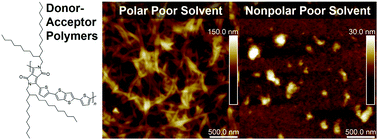Self-assembly of donor–acceptor conjugated polymers induced by miscible ‘poor’ solvents†
Abstract
The solution-phase self-assembly of donor–acceptor conjugated polymer (DACP) poly[2,5-(2-octyldodecyl)-3,6-diketopyrrolopyrrole-alt-5,5-(2,5-di(thien-2-yl))thieno[3,2b]thiophene] (DPPDTT), is demonstrated and investigated from binary solvent mixtures. It is found that the polarity of a miscible ‘poor’ solvent (e.g. methanol, dimethyl sulfoxide), which is added to a stable polymer solution in chloroform (i.e. ‘good’ solvent), strongly affects the resulting nanostructure. Nanoribbons are formed by the addition of certain polar (e.g. methanol) ‘poor’ solvents to the mixture, while amorphous aggregates are formed upon addition of non-polar ‘poor’ solvent, such as n-hexane. Atomic force microscopy (AFM), scanning transmission electron microscopy (sTEM) and small angle neutron scattering (SANS) are used to characterize the shape and size of the nanostructures. Experiments show complex self-assembly in solution occurs for DACPs when compared to conjugated homopolymers. SANS results also provide quantitative analysis of DACP conformations in solution before self-assembly occurs. The addition of different polar ‘poor’ solvents could also alter the size of the assembled nanostructures, as well as the fraction of polymers that self-assemble. The surface orientation and the crystal structure of the nanostructures is also probed by grazing-incidence wide-angle X-ray scattering (GIWAXS). Organic field effect transistors (OFETs) are used to characterize charge transport properties for nanoribbons where enhancement of the average hole mobility is observed.



 Please wait while we load your content...
Please wait while we load your content...
